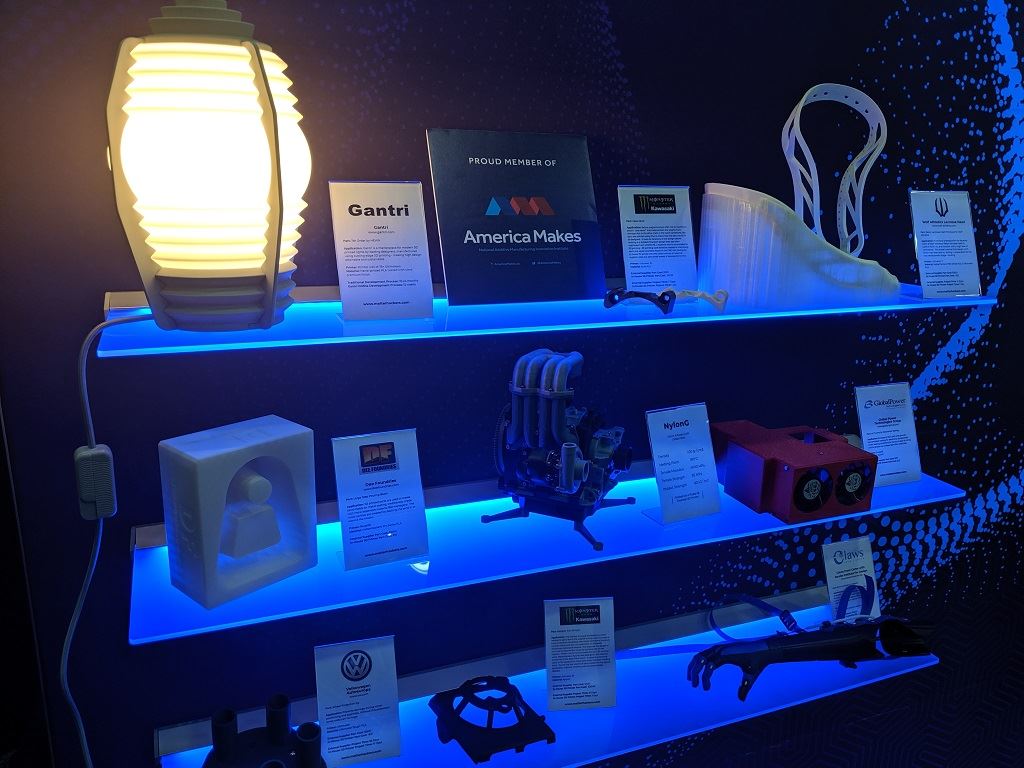![Highlighted applications from MatterHackers [Image: Fabbaloo]](https://fabbaloo.com/wp-content/uploads/2020/05/image-asset_img_5eb09607947d5.jpg)
A conversation with MatterHackers points to a maturing digital fabrication environment.
Last year, the reseller didn’t exhibit at RAPID + TCT. Having had a booth the previous year, they found “the conversation wasn’t there yet,” said Mara Hitner, MatterHackers’ Director of Business Development. But in 2019, “it’s time.” And more than that: “It’s time for desktop.”
Capabilities have been improving across the board, including what’s available to makers. Desktop 3D printers are offering better resolution and smoother performance than ever before, but that’s not perhaps the most noteworthy aspect of the industry today.
The Materials Story
“It’s really driven by the materials story,” said Hitner.
She’s in a good position to know, as during this year’s RAPID event MatterHackers announced a number of new materials partnerships, offering more advanced 3D printing materials from the likes of BASF, DuPont, DSM, and Dow. Each of those companies, in turn, had their own in-depth 3D printing materials stories to tell.
And for all, it comes down to one important aspect: the user, and the usage. Especially for desktop machines, we’re seeing rising usage across the board in 3D printing jigs, fixtures, tools, molds, and even final parts. Prototyping and spare parts production are also up there in important uses.
“Desktop and additive manufacturing in general are all about applications,” Hitner told me. “We haven’t had this degree of success possible yet; we needed more reliable performance, even at smaller budget points. Now more and more machines and materials are affordable.”
The new materials were a highlight, as “materials that had only been injection moldable are now on desktop 3D printers,” Hitner noted.
In addition to that, CMO Dave Gaylord noted, MatterHackers has been working directly with NatureWorks. MatterHackers’ PRO Series Breakaway Support uses Ingeo 3D450, introduced earlier this spring.
“They do a great job of paving the way in describing the ‘mystery meat’ of materials,” Gaylord said.
Along with the new materials themselves, MatterHackers’ announcement with FiberForce for the Pantone Color Matching system is up and running.
“On our website today you can search Pantone and get more than 30 results back of Pantone-certified colors. You can also order custom for any desktop 3D printer now,” Hitner said.
During this year’s RAPID, MatterHackers saw that there was “a lot of interest” in the new materials they were offering, Hitner said, as well as in their featured offerings from Ultimaker, BCN, Magigoo, and Slice Engineering. The booth featured a number of designs across different application areas, from engine models to a lovely lamp.
![[Image: Fabbaloo]](https://fabbaloo.com/wp-content/uploads/2020/05/matterhackers21_img_5eb0960831503.jpg)
Pulse On Equipment
MatterHackers is a reseller, but through great familiarity with the space also introduced its own 3D printer last year, the Pulse.
“It started as a custom printer, kind of like the Dell model where we have a base and you add as you like. We had a lot of common requests, so made the Pulse SE, which can print abrasive materials, as a preconfigured model. We have the Pulse HV for fast printing. Coming soon there will be a dual extruder version, specifically designed for nylon composite materials and specific supports. That’s still TBD, but will be out soon,” Hitner said.
“The Pulse is meant to fill this gap where people want bells and whistles — but they don’t want to pay for the bells and whistles they don’t want. It’s application-driven. It’s like ordering a pizza, you can go custom or choose from customer favorites.”
![Mara and the MatterHackers team finalize setup just before the exhibit floor opened for RAPID + TCT 2019 [Image: Fabbaloo]](https://fabbaloo.com/wp-content/uploads/2020/05/matterhackerssetup1_img_5eb0960887c81.jpg)
MatterHackers got its start in 2012 and has been moving forward and growing up with the 3D printing industry. So much so that, along with the industry, it’s growing up into Industry 4.0.
“We’re transitioning from a 3D printing retailer to a digital fabrication retailer,” Hitner said. “We offer 3D printing, but also CNC, laser cutters and engravers, vacuum formers. You can get anything needed for digital fabrication, and really match up with the right technology.”
As always: the most important thing is finding the right tool for the job. Sometimes that’s 3D printing, sometimes that’s 3D printing with a new engineering-grade material, and sometimes that’s molding or cutting.
Via MatterHackers











The use of “3D Printing” is beginning to fade, at least with respect to application-focused 3D print services. As for the rest, we’ll find out what happens.